Will the Real California Happy Cows Please Stand Up?
Last summer, I was invited by the California Happy Cows campaign (California Milk Advisory Board) to visit the “real California Happy Cows” at a California dairy farm.

Last summer, I was invited by the California Happy Cows campaign (California Milk Advisory Board) to visit the “real California Happy Cows” at a California dairy farm.
How could I pass this up? I had never visited a dairy farm, and I was curious to see what it was all about.
Apparently, the PR agency who invited me to tour the farm where the “California happy cows” live did not read my blog — otherwise, I don’t think they would have invited me.
Confession time: I’ve been drinking raw, grass-fed milk from Organic Pastures Dairy for the past 3 1/2 years. I am a believer in the benefits of real, raw milk from grass-fed cows.
Sorry, PR agency people. I enjoyed spending time with you — you’re all really nice. I’m not just saying this — I really mean it.
Thanks for the swell trip. You were gracious and sweet. But oops — you should have read my blog first.
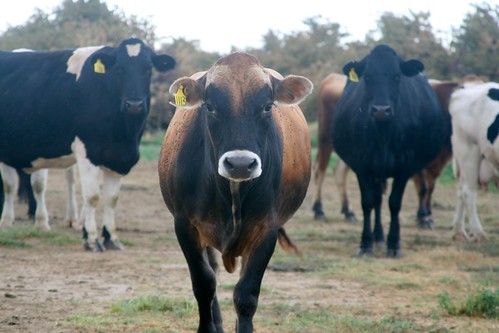
A Tale of Two Dairies
We’re going to take a look at a conventional California dairy farm, Clauss Dairy Farms, compared to Organic Pastures Raw Milk Dairy. Two completely different beasts.
I think, after reading this posts, you will question where your milk comes from. And if you’re already drinking raw milk from a pasture-based dairy, you can rest in the knowledge that you are doing the right thing.
Biased, much?
Yeah, OK. I’ll admit it. I drink raw, grass-fed milk. Exclusively. And I like it. No, I love it.
But I went on these excursions as an objective reporter. I did my best anyway. I looked at the facts. And I asked questions. Were the cows happy? Were they well-nourished? Were they comfortable? Were they living in harmony with nature?
If these trips to visit local dairies had swayed me from my love of raw milk, then so be it. I would have stopped paying for raw milk and switched to the cheap stuff. I was fully prepared for that.
But they did not sway me. Let’s venture on, dear reader.
Clauss Dairy: Conventional and Corn-fed
Last summer, along with dozens of other bloggers from around the country, I was flown to San Francisco, courtesy of the California Milk Advisory Board. We were greeted by employees of their San Francisco PR firm. They escorted us by tour bus to a fancy cheese tasting and dinner. We stayed overnight at a hotel and spent the next day touring Clauss Dairy, a conventional dairy farm that makes cheese.
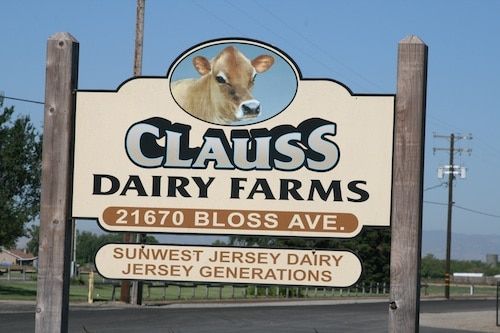
According to the California Milk Advisory Board, 99% of California dairies are family-owned. That sounds really good, doesn’t it?
Except for the fact that that includes dairies with 10,000 cows.
Clauss Dairy is one of these “big ag” dairies, and it’s a family farm, although it’s on the smaller size. They only have 2,000 cows. The milk from these cows goes to a local plant to make cheese. If you are eating (most) grocery store cheese, chances are it is come from this Northern California cheese factory.
Fancy Barns and “Comfortable” Cows
Their cows at Clauss Dairy live in very expensive open-air barns. They seem perfectly comfortable. They lie in composted manure and stand in mud mixed with manure.
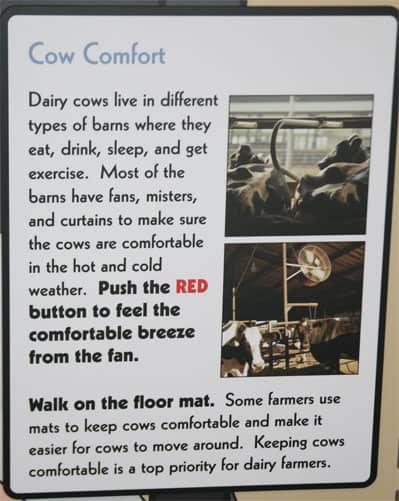
Most of the time, they are not exposed to direct sunlight since the barns are covered. Are they happy? I don’t know. They seem perfectly comfortable, and they don’t seem unhappy.

I did not like the fact that the cows are not in the sunshine. Why? Because if they don’t get sun, they’re not going to be producing as much vitamin D. I’m not a scientist or a nutritionist — that’s just common sense. When I asked the people at Clauss Dairy Farms why they don’t let their cows out into the sun, they said it was too hot for them. This just didn’t make sense to me.
Now, they do get some sunshine each day when they’re standing around waiting to be milked. They have to wait for 45 minutes to get on this circular conveyor belt contraption that milks them.
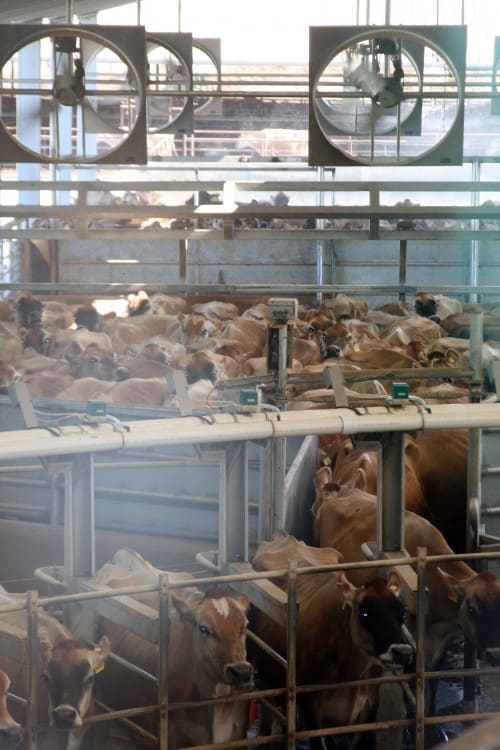
Honestly, they didn’t seem unhappy on the modern milking contraption. However, I wouldn’t say they looked “happy” either. And it did seem to be a very expensive way to get the job done.
The cows at Clauss also get some some sunshine, when they’re lined up to eat their grains.
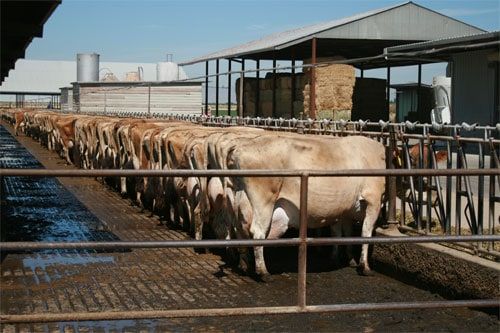
Now, I want you to look at that cow’s udder. Here’s a closeup:
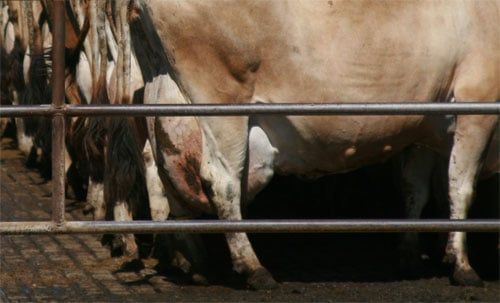
Notice how huge it is. This is not normal, as you will see in the photos I took at Organic Pastures organic dairy farm. Here’s an example of a cow at Organic Pastures — note the normal-looking udder:
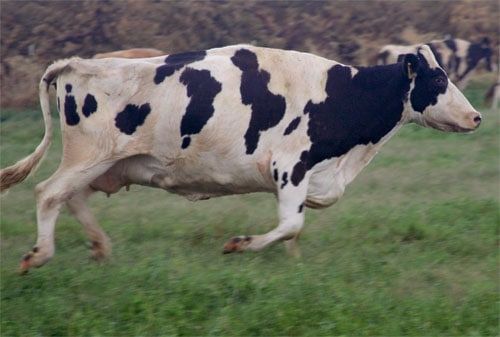
I wondered it if Clauss Dairy was giving their cows a lot of hormones to make them produce more milk. I am not sure — I did not ask. But something doesn’t look right about those udders. And I didn’t see a single cows looking like like that at Organic Pastures.
When I asked how long the cows lived on average at Clauss Dairy, they told me five years. In reality, cows have a life span of 20 years. But their life span is typically much shorter on these concentrated animal feeding operation (CAFO) dairy farms.
Eww That Smell!
Although they may get some sun, the cows at Clauss Dairy are definitely not getting any fresh air. In fact, nobody gets fresh air at Clauss, not even the family who lives across the street.
The one thing I remember, more than the fancy dinner or Top-Chef-catered lunch, was the stench of that place. Even when we were outside eating our fancy lunch in the backyard of the owner’s house, I really could not enjoy my food because the smell was so horrible.
It is important to note that the cows at Clauss Dairy (and other conventional dairies like it) have no access to pasture. They don’t get to eat grass. If the were out on pasture, the manure would get mixed into the ground, fertilize the soil, rebuild the topsoil.
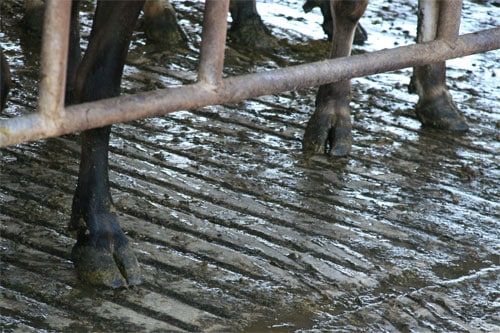
Instead, the manure is just sitting there on the cement. The cows stand around, producing more manure, that then has to be cleaned up and turned into “compost”. Seems like an odd waste of energy, eh? Why not just leave them out in the pasture, especially in California, where the sun shines all year long?
Cows Eating Frito-Lay Chips?
Instead of eating grass, the cows at Clauss Dairy eat a blend of grains designed by a nutritionist.
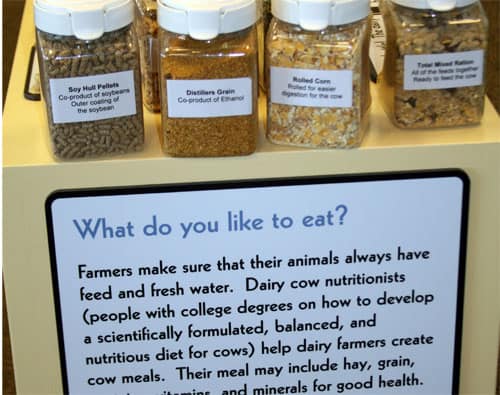
The nutritionist was very proud of the fact that they supplement the cow’s feed with chips trucked over from the local Frito Lay plant.
They all thought this was a great thing, stressing that it was “better for the environment.” They smiled proudly and said, “Otherwise, those chips would end up in a landfill.”
All I could think was, Yeah, maybe they should end up in a landfill.
Personally, I like to eat my cheese without transfats. And if the cows are eating chips fried in transfats, it’s going into their milk, which goes right into the cheese.
Now I don’t have any proof that there are trans fats in the cheese produced from conventional dairies. It’s just a theory. Here’s my reasoning: we know that trans fats are ending up in the breast milk of women in industrialized countries who eat foods made with trans fats Therefore, it’s only logical that it would end up in the cow’s milk, too when they eat our junk food. Read this study on trans fats in breast milk in The American Journal of Clinical Nutrition.
So, yeah, I’m not a fan of them feeding chips (what I call junk food) to cows. It’s just wrong. I mean, it’s one thing if I knowingly eat a bag of potato chips and ingest a bunch of transfat-laden, rancid vegetable oil. But is it right to feed this to a cow, a cow who is meant to eat grass and hay?
And what about eating cheese made from the milk of animals who ate the chips? No, thanks. At least if I buy a bag of chips, I know what I’m getting. If I buy some cheddar cheese, how do I know what’s in it? If the cows ate chips and bakery waste (most conventional dairy farms also feed their cows day-old baked goods including doughnuts and white bread), what is really in that cheese?

Sure, the cows at Clauss Dairy Farms do get hay, but they also get lots of genetically modified corn, soy, and other grains. All sprayed with pesticides and herbicides. Ironically, most of the corn they eat is grown right there on the Clauss family land.
I have to tell you, it was totally bizarre to see acres and acres of cornfields, all this GMO (genetically modified) corn, instead of pasture. Why go to all the trouble of growing all this corn, only to have to cut it down and process it and lug it over to these huge barns and then feed it to the cows? And why put the cows in expensive barns instead of putting them on pasture?
Why not just let them eat grass?
A perfect segue to the next dairy I visited, Organic Pastures, where the cows eat grass in the sunshine, 365 days a year.
Organic Pastures Dairy: Organic and Grass-fed
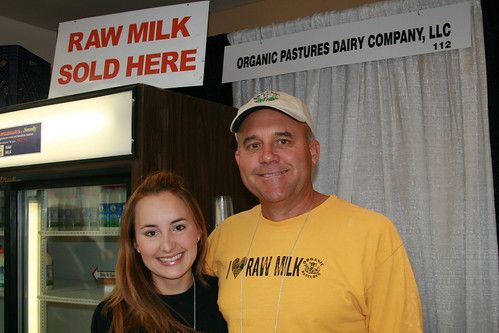
Mark McAfee, retired EMT, started Organic Pastures 10 years ago, after inheriting the family farm. Organic Pastures is a small farm, situated on 400 acres, milking around 350 cows daily. They have 49 employees including their two grown children, who live close by and have both recently blessed the McAfees with grandchildren.
I visited the dairy last September. After a sunset walk through the pasture and a screening of FRESH, we sat around the kitchen and talked. Mark’s wife, Blaine, a retired registered nurse, offered me delicious beef stew from the crockpot, olive bread and Organic Pastures cheese. And for dessert: Trader Joe’s chocolate cake. I sipped red wine as they told me the story of how Organic Pastures Dairy came to be.
“From the beginning, it was always a family affair,” said Mark, as Blaine did the dishes. She paused to kiss and hug her grandbaby goodnight.
Daughter Kaleigh, now employed as Organic Pastures’ Marketing Manager, said she was in middle school when her parents started the dairy. “It was a lot of work, but it was fun.”
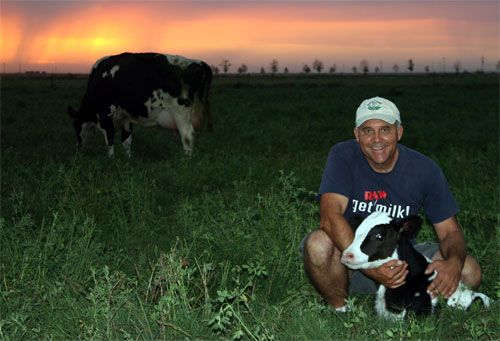
Kaleigh told me that they never fed their cows grain, and never planned to. She said grain is a huge investment. “You have to go into a lot of debt to buy those huge barns and tons of grains and the cement slab milking parlor.” She said if they ever wanted to quit running the dairy, it would be really hard to get out. A lot of conventional and even organic dairy farmers are stuck in this predicament. “They have to go really big or they can’t make money.”
Kaleigh explained that they never intended to make raw milk. They never even drank the raw milk the cows produced — they had a pasteurizer they would use in order to drink it. They were sure they’d get sick if they drank it raw. In the beginning, Mark was the only one who would drink it raw. Back in those days, they sold all their organic, grass-fed milk to Organic Valley.
Then one day, Hollywood movie star Daryl Hannah showed up on the farm. She said she wanted raw milk and asked if they would sell it to her.
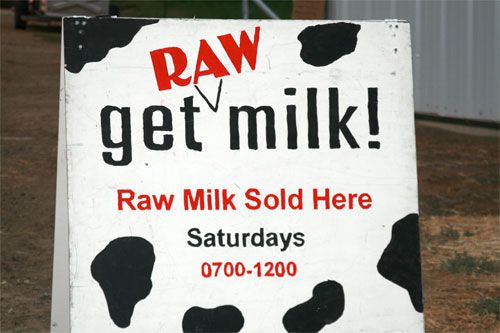
You see, Los Angeles residents had been cut off from their raw milk source. Back in the day, Angelenos bought raw milk from Alta Dena Dairy. But people started getting sick. Alta Dena shut down their dairy. However, it should be noted that Alta Dena cows were not eating grass — they were eating grain.
When they got wind that there was a dairy with cows eating grass 365 days a year, raw milk lovers in Southern California — including a number of other Hollywood celebrities — wanted this milk raw.
So they started trucking raw milk to LA — driving it down every week, storing it in coolers. “Like hillbillies,” Mark said.
Eventually they started selling it in Whole Foods. (Which they no longer do, since Whole Foods decided to stop carrying their raw milk last year.)
Until the Cows Come Home
Mark said he flies around in his plane (he has a pilot license) and videotapes what the land looks like. The only green grass for grazing cows is his pastures.
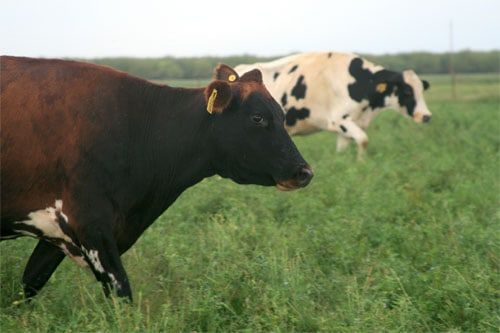
The cows at Organic Pastures never do “come home” because they are always home — out on the pasture. They have a “mobile milking parlor” so they can milk the cows twice a day — out on the grass. There is no need for expensive barns or milking parlors. The cows even mate out in the pasture — there is no artificial insemination.
They’re also introducing a Joel-Salatin-style egg mobile and will be selling their first truly pastured eggs this spring.
After visiting the conventional farm last summer, one of the most striking things to me about visiting Organic Pastures Dairy was there was no smell. The conventional dairy had a foul manure stench that permeated the whole place.
But at Organic Pastures, there was no smell. None whatsoever. I could not get over that. Even though the cows are just across the street (you can see them grazing from the window,) I couldn’t smell any manure. When my husband and daughter and I went to bed in the guest room, I opened the window so we could enjoy the cool breeze of fresh air.
The McAfees had left very early in the morning to go to a family funeral. Mark told me it was fine for me to go out and take photos of the cows. Blaine showed me where the coffee was, as well as the bread for toast, bacon, Organic Pastures butter, and eggs (from their chickens) and we all hugged goodnight.
Communing with Cows
When I woke up at 7 am, it was raining. I was so disappointed, because I had been so excited to get out and take photos of the cows. (We had arrived late the night before for the sunset walk, so we missed most of it.)
Luckily, the rain cleared up just as fast as it came. After a cup of coffee and a chat with the other out-of-towners who were staying in the other guest room, I headed out to the pastures just across the street. Their two friendly dogs happily led the way.
I’ve never experienced anything like this in my life. The grass was still wet from the rain. The sun was coming up and the air was fresh and clean. The only sound was the cows’ soft mooing and birds singing.
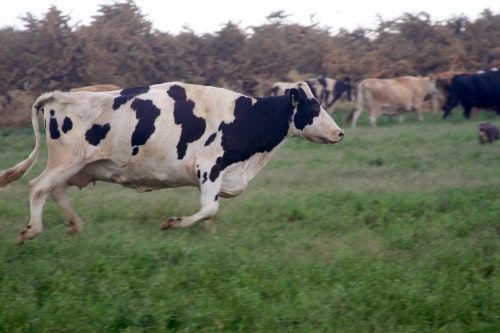
I felt peaceful and my heart was full of joy. Being on the pasture in the early morning mist with these majestic, docile animals was truly magical.

The dogs were frolicking — herding the cows. They looked like they were dancing and playing, having a high old time. The cows even seemed to enjoy it. Cows and dogs together, playing in the sunshine.
Just watch this video:
The cows came right up to me and smelled me, butted me with their heads, licked the backs of my hands.
At one point, I noticed a newborn calf — who had obviously been born moments ago — moving toward me, making his way on wobbly legs. Three very large cows stayed very close to him, protecting him, mooing low and long, warning me not to make any sudden moves.
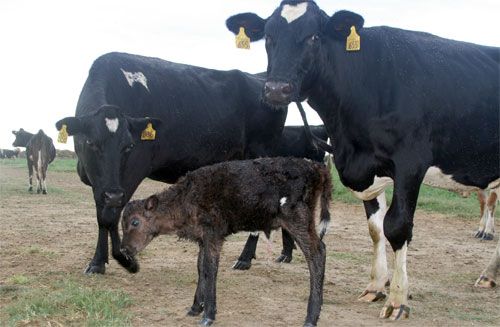
The calf came right up to me and smelled me, as I kneeled on the ground. The three larger cows were so close they could have crushed me. I stayed stock still, scared that if I moved, they’d buck. I felt like Dian Fossey in Gorillas in the Mist.
California Happy Cows
As we drove back to LA that morning, my heart was warm and glowing and my head felt bubbly like Champagne. Organic Pastures Dairy really felt like such a miraculous place, a farm where animals and humans live in perfect harmony with nature.
Yes, these are truly happy cows.
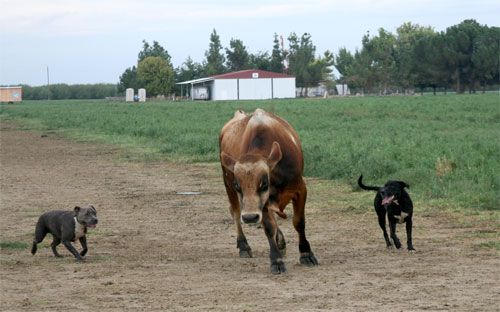
But most of the dairies in California do not operate this way. If you want to buy milk and cheese from happy cows, you’ll need to buy it from Organic Pastures.
Saving Lives with Raw Milk
It’s not just the miracle of the cows and dogs and chickens living the way they were meant to live, it’s more than that. It’s a retired EMT and RN who have stepped off the grid of the conventional medical system and are now living their dream of saving lives.
Before the movie screening the night before, Mark told the audience how he had recently visited a mom’s group — all the mothers had kids on the autistic spectrum. There was one mother, he said, who had a young boy who had a kind of facial tic that was so bad, he could not even attend school.
Mark said, within 24 hours on raw milk, the facial tic disappeared.
Mark’s got a million of these stories. You can’t have lunch with him without hearing one after another. This is what drives his passion and it’s absolutely contagious.
But I don’t need to hear it from Mark. The people I’ve met over the years who drink raw milk all have stories. Just ask them. They’ll tell you how they cured their lactose intolerance, how they got rid of their asthma, how their allergies disappeared.
Its the dramatic changes in people’s health that is creating an army of rabid raw milk evangelists. And we’re not going away.
Happy cows are the beginning, but not the end of this story. Happy cows, sustainable family farms, lush green pastures, transformed health — this is the vision I want to support, and why I only buy dairy products from grass-fed cows from sustainable farms.
Find Raw Milk
If you’re looking for raw, grass-fed milk and cheese in your area, visit the Real Milk website.
Share Your Comments
Are you still drinking conventional or even “organic” milk or have you gotten off the grid to raw, grass-fed dairy?
Do you have a raw milk testimonial to share?
Please share your comments below.

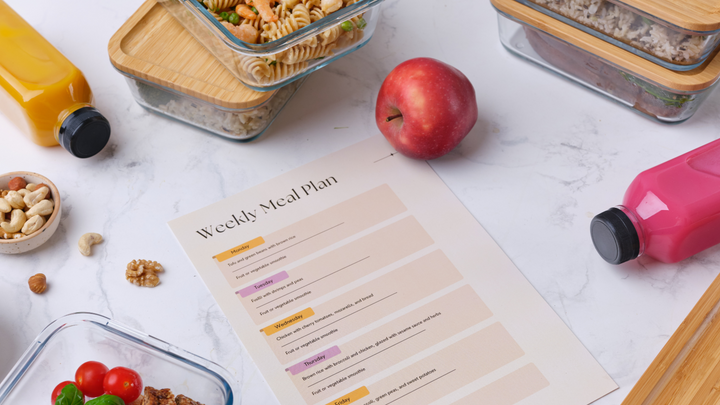

Comments ()